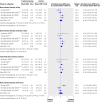Effects of vitamin D supplementation on bone density in healthy children: systematic review and meta-analysis
- PMID: 21266418
- PMCID: PMC3026600
- DOI: 10.1136/bmj.c7254
Effects of vitamin D supplementation on bone density in healthy children: systematic review and meta-analysis
Abstract
Objective: To determine the effectiveness of vitamin D supplementation for improving bone mineral density in children and adolescents and if effects vary with factors such as vitamin D dose and vitamin D status.
Design: Systematic review and meta-analysis.
Data sources: Cochrane Central Register of Controlled Trials, Medline (1966 to present), Embase (1980 to present), CINAHL (1982 to present), AMED (1985 to present), and ISI Web of Science (1945 to present), last updated on 9 August 2009, and hand searching of conference abstracts from key journals. Study selection Placebo controlled randomised controlled trials of vitamin D supplementation for at least three months in healthy children and adolescents (aged 1 month to <20 years) with bone density outcomes. Two authors independently assessed references for inclusion and study quality and extracted data.
Data synthesis: Standardised mean differences of the percentage change from baseline in bone mineral density of the forearm, hip, and lumbar spine and total body bone mineral content in treatment and control groups. Subgroup analyses were carried out by sex, pubertal stage, dose of vitamin D, and baseline serum vitamin D concentration. Compliance and allocation concealment were also considered as possible sources of heterogeneity.
Results: From 1653 potential references, six studies, totalling 343 participants receiving placebo and 541 receiving vitamin D, contributed data to meta-analyses. Vitamin D supplementation had no statistically significant effects on total body bone mineral content or on bone mineral density of the hip or forearm. There was a trend to a small effect on lumbar spine bone mineral density (standardised mean difference 0.15, 95% confidence interval -0.01 to 0.31; P=0.07). Effects were similar in studies of participants with high compared with low serum vitamin D levels, although there was a trend towards a larger effect with low vitamin D for total body bone mineral content (P=0.09 for difference). In studies with low serum vitamin D, significant effects on total body bone mineral content and lumbar spine bone mineral density were roughly equivalent to a 2.6% and 1.7% percentage point greater change from baseline in the supplemented group.
Conclusions: It is unlikely that vitamin D supplements are beneficial in children and adolescents with normal vitamin D levels. The planned subgroup analyses by baseline serum vitamin D level suggest that vitamin D supplementation of deficient children and adolescents could result in clinically useful improvements, particularly in lumbar spine bone mineral density and total body bone mineral content, but this requires confirmation.
Conflict of interest statement
Competing interests: All authors have completed the Unified Competing Interest form at
Figures

Comment in
-
Vitamin D and bone health in children.BMJ. 2011 Jan 25;342:d192. doi: 10.1136/bmj.d192. BMJ. 2011. PMID: 21266419 No abstract available.
-
Vitamin D supplementation of deficient children may improve bone mineral density.Evid Based Med. 2011 Oct;16(5):153-4. doi: 10.1136/ebm1401. Epub 2011 May 10. Evid Based Med. 2011. PMID: 21561930 No abstract available.
References
-
- Johnell O, Kanis JA. An estimate of the worldwide prevalence and disability associated with osteoporotic fractures. Osteoporos Int 2006;17:1726-33. - PubMed
-
- Burge R, Dawson-Hughes B, Solomon DH, Wong JB, King A, Tosteson A. Incidence and economic burden of osteoporosis-related fractures in the United States, 2005-2025. J Bone Miner Res 2007;22:465-75. - PubMed
-
- Riis BJ, Hansen MA, Jensen AM, Overgaard K, Christiansen C. Low bone mass and fast rate of bone loss at menopause: equal risk factors for future fracture: a 15-year follow-up study. Bone 1996;19:9-12. - PubMed
Publication types
MeSH terms
Substances
LinkOut - more resources
Full Text Sources
Medical
